If you want to choose beautiful, easy care indoor plants for your home, this article can help. I’m going to tell you about 29 of the best houseplants for beginners that are easy to care for and will look amazing in your home. I’ve included some of my all-time favorites that I know you will love.
What are the best houseplants for beginners? Low-maintenance houseplants that are easy to grow and require minimal care are good choices for beginners. The best houseplants for beginners include Peperomia, Spider Plant, ZZ plant, and Phalaenopsis Orchids.
Whether you are a novice or a seasoned gardener, you will undoubtedly enjoy a plant that looks great without demanding too much of your time and attention. You should also look for a plant that doesn’t suffer too many issues and sensitivities either. Below we take a closer look at some of the best easy care indoor plants.
1. Peperomia
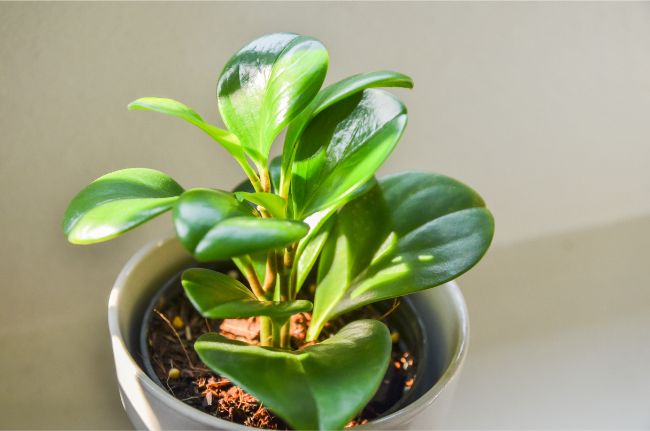
The Peperomia is a great feature piece on a table, desk or shelf. There are over 1000 species of Peperomia to choose from and they come with thick waxy drought-tolerant leaves in variegated, solid, or marbled red, purple, gray, or green shades.
Peperomia are chosen for their beautiful, ornamental leaves, which come in a wide variety of shapes, sizes and colors, depending on the variety.
The Peperomia makes for a great houseplant for beginners because it’s quite forgiving and can withstand a decent amount of neglect. The plant can grow alone or grouped with other varieties for interest. It doesn’t often grow over 12 inches tall and while it requires medium to bright light, it is not too sensitive to light fluctuations.
Provide the plant with loamy potting soil (it also enjoys chunky orchid potting medium) with good drainage, place it in a bright room (it does not require direct sunlight) and water it once the top half of the soil is dry. That’s all that’s required to keep your Peperomia growing happily.
If you want to know everything about looking after a Peperomia houseplant, I have written a complete guide here.
2. Spider Plant (Chlorophytum Comosum)
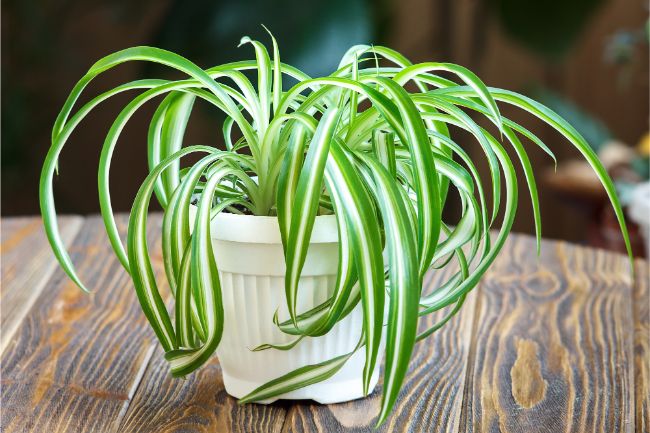
The Spider Plant, aka Hen & Chicken Plant or ribbon plant, is a popular houseplant for beginners. This elegant plant features long, sword-like green, cream, and white leaves that grow from a central point at the base.
These plants are tough, easy to grow and require minimal maintenance. They do best in hanging baskets, but also thrive when placed on a table or shelf in a bright room (no direct sunlight required). It is a highly-adaptable houseplant, as it can grow in almost any environment when given time to “settle”.
The Spider Plant has no adverse reactions to being moved to a new environment, so you won’t have to worry about moving it about your home.
All that is required is a bright spot and moist soil to keep a Spider Plant happy. Only water your Spider Plant if the soil is dry. Be careful not to overwater the plant as it can lead to wilting and root rot.
The most common problem with Spider Plants is when they develop brown leaf tips. I’ve This can easily be prevented, and I’ve written an article explaining exactly how to treat your Spider Plant to keep it in top condition.
3. Wandering Jew Plant (Tradescantia Zebrina)
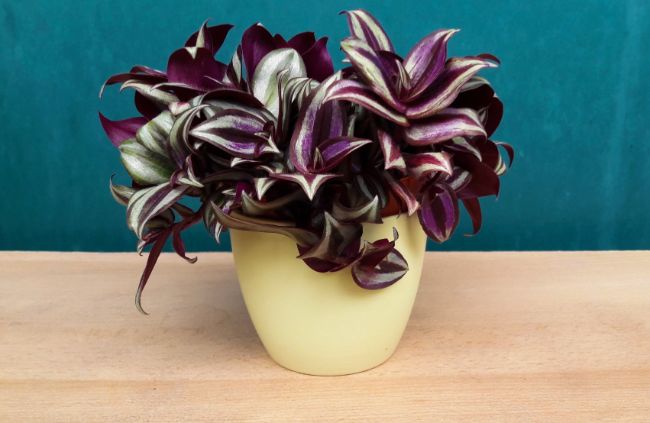
The Wandering Jew makes for a good beginner’s houseplant mostly because it is considered ‘difficult to kill’. This attractive plant, native to Mexico, has striped leaves and shows growth on the upper surface. Purple growth is new growth whereas green growth is older growth. The easy-to-grow Wandering Jew is a flowering plant that typically blooms purple, pink, and white, in spring or early summer.
The Wandering Jew makes for a great hanging basket plant as it loves to cascade, but it can be placed on a high shelf too. This houseplant has only a few requirements, with high humidity levels and moist soil being two of them.
If you live in a home with dry air, you might need to put some effort into maintaining humidity and keeping the soil moist (if the soil dries out completely the roots might die). Grouping your houseplants, using a humidity tray, or investing in a humidifier work well to maintain good humidity levels.
As the plant grows, it might start to look thin and scraggly. You can rectify this by cutting the tips off the plant. A good trim enables the plant to grow back thick and full. I’ve written a complete guide to caring for Wandering Jew houseplants, so read more if you think this is the plant for you.
4. Cast Iron Plant (Aspidistra Elatior)

The name of the Cast Iron Plant gives away just how tough it is – it’s nearly indestructible! It is part of the Lily family and native to China and Japan. This plant is a top choice for beginners as they can withstand quite a lot of neglect and live up to 50 years.
The Cast Iron Plant has dark green, long pointed line-textured leaves and looks great grouped with other plants, or alone in a corner. The biggest benefit of this houseplant is that it is a slow-grower. It only produces a few leaves each year and won’t outgrow its location.
You can expect the Cast Iron Plant to be easy to please, as it does well in low light, low humidity and fluctuating temperatures. Although the Cast Iron Plant will tolerate neglect really well, it wont be so happy if you overwater it. The plant above sits in my hallway and I just check the soil for dryness once a week. I probably only water this plant once every 2-3 weeks at most and it is thriving.
I absolutely love Cast Iron plants and would highly recommend them to add some greenery to your home. Read my guide to Cast Iron Plant care, where I go into detail about how to keep your plant looking great, and provide a few tips to avoid some common problems.
5. Fiddle Leaf Fig (Ficus Lyrata)
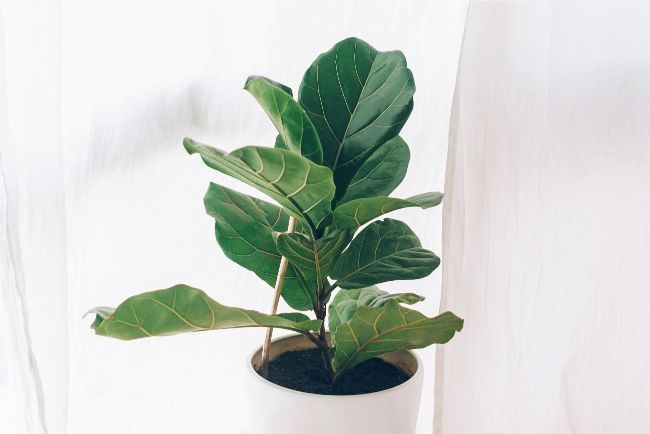
The Fiddle Leaf Fig is a trendy houseplant and features in many fashion-forward interior décor magazines. This is a tall columnar plant that doesn’t get very bushy. It’s a great filler and an interesting piece for corners and tight spaces. The leaves are big, waxy, dark green, and shaped like a violin, hence the name.
There’s a misconception that the Fiddle Leaf Fig is difficult to care for. Native to the tropics, this particular houseplant loves warm, wet, and humid environments, which isn’t always easy to provide in the average home. Don’t let that scare you off though.
Simply provide the Fiddle Leaf Fig with bright filtered light and plenty of water, and it will thank you for it by flourishing.
The Fiddle Leaf Fig does require a bit more attention than the average houseplant, so it’s only really suited to a beginner who has time and interest in the plant. It is a species that is susceptible to disease and pest infestation and often you will find such a plant with leaf fungi or disease spots. They can also start to drop their leaves if they are exposed to drafts, big temperature fluctuations, and humidity levels that keep changing.
Despite this, the Fiddle Leaf Fig can be a great plant to get if you want to hone your skills in houseplant care while enjoying the stunning foliage.
6. Madagascar Dragon Tree (Dracaena Marginata)
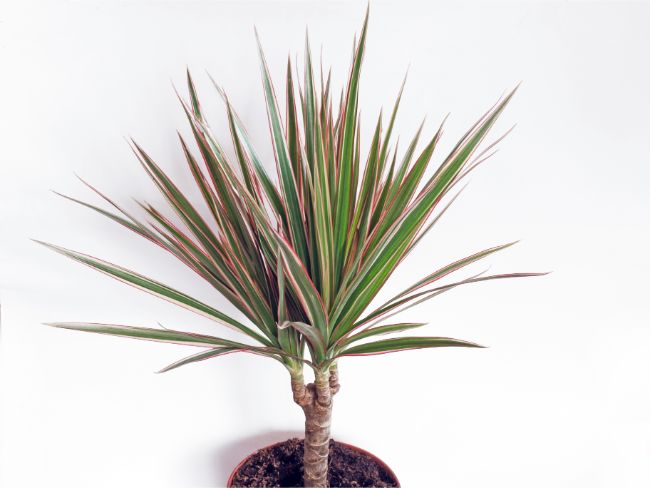
The Dracaena Marginata is one of the most popular houseplants for beginners. It is easy to grow and even easier to maintain. The Madagascar Dragon Tree can grow up to 6ft over 10 years. The Marginata has slim, attractively arching leaves, which can be green with a red outer edge, or green with a red & yellow stripe through the leaf, or green with very thick red outer edges.
These plants enjoy potting soil that is kept slightly moist. However, many owners have reported their Madagascar Dragon Tree reviving and thriving, even after months of neglect and no water.
Beginners need to pay attention to pruning, to ensure that the leaves grow neatly upwards and not in all different directions. Attention must also be given to potential Mealybug or Scale infestation as the plant is susceptible to these plights.
The leaves naturally shed from the bottom and can simply be removed. A point to note is that the Madagascar Dragan Tree is toxic to both cats and dogs. It seems to attract cats (they like to chew on the leaves), so this isn’t the best option for beginner houseplant owners who have pets.
Read my in depth guide to looking after a Madagascar Dragon Tree. I cover how to provide great care and cover the most common issues that you might have and how to prevent them.
7. ZZ Plant (Zamioculcas Zamifolia)
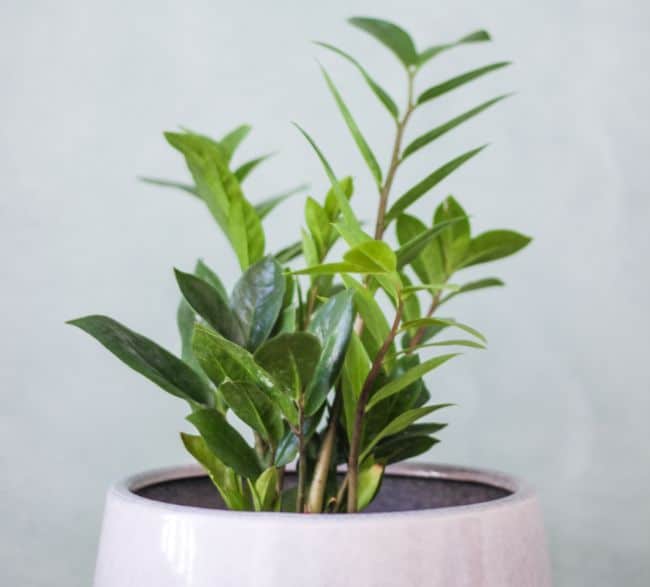
The ZZ Plant is hardy with sharp, pointy dark green leaves that are waxy, smooth and shiny. It is mainly a foliage plant, rarely blooming in mid-summer with small, demure white flowers and never growing more than 3ft tall. For beginners looking for an ultra-tough house plant, the ZZ Plant is a great choice.
The ZZ Plant barely notices drought and low-light conditions, even though it prefers bright indirect sunlight and well-draining soil (any well-draining soil is fine). The plant only needs water when the potting soil is fully dry and even if you leave it a bit overdue, it won’t show any extreme adverse effects.
While there’s no need to fertilize the ZZ Plant, you can fertilize it in summer, with a double diluted water soluble plant food. The ZZ Plant is resistant to insect infestation and disease.
Unfortunately, while the ZZ Plant looks great and is easy to care for, you will need to wash your hands after handling it and keep children and pets away from nibbling and playing it, as the ZZ Plant is poisonous.
8. Guzmania Bromeliads
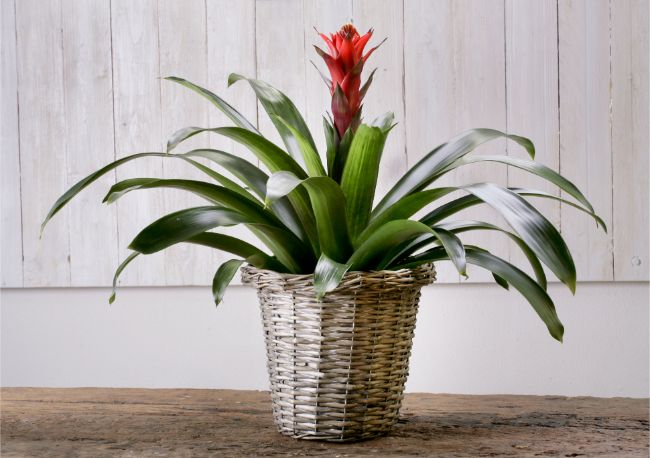
The Bromeliad is a bright and cheerful houseplant that is a rewarding choice for both beginner and seasoned gardeners alike. Bromeliads come from the Pineapple family and are delightful when properly cared for. These tough, long-lasting, forgiving plants bring a touch of class and color to almost any home.
In nature, Bromeliads grow in hot environments, under canopies of trees. As such, they thrive in bright, indirect light. For best results, position it near a window with east or west exposure.
For beginners, the water requirements are the best feature. You only need to water your Bromeliad once a month.
Plant the Bromeliad in a well-draining soil with rich organic matter (orchid growing medium is great), place it near a window in a bright room and that’s it – watch your plant grow and thrive. There’s no need to fertilize or prune the Bromeliad, and while some species are prone to Mealybug or scale, this very rarely happens.
I’ve covered caring for Guzmania plants in this article, where I go through all the aspects of care you should know.
9. Moth Orchid (Phalaenopsis)
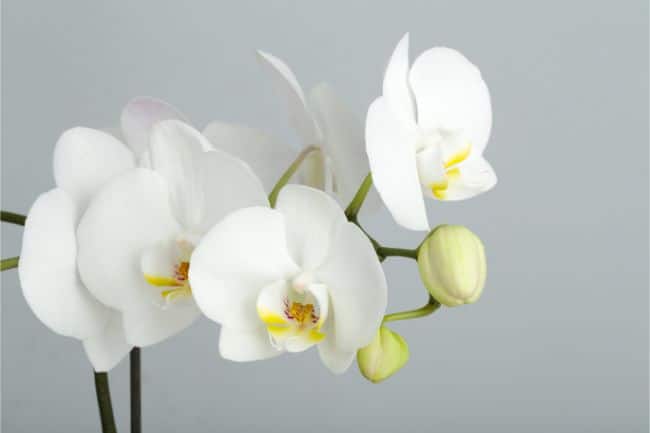
The Phalaenopsis Orchid, aka Moth Orchid due to the shape of its blooms, is a wonderful choice of houseplant. With stunning blooms that last for up to 4 months, and low care requirements, I would hugely recommend them. Many people have the false impression that Phalaenopsis Orchids are hard to look after, but nothing could be further from the truth.
The great thing about Phalaenopsis Orchids is that they will bloom once or twice per year for months at a time, and the orchid can live for decades if looked after correctly.
This type of orchid shouldn’t be grown in soil and must be planted in fir bark, clay pellets or sphagnum moss.
To avoid overwatering, which is sure death to an orchid, make sure the potting media fully dries before watering again. It’s fairly easy to see if the orchid is distressed. The leaves should be leathery and strong and a rich green color. Pay attention to changes in the color of the leaves or signs of wilting or wrinkling of the leaves, which can indicate a problem.
Phalaenopsis Orchids require decent amounts of indirect sunlight but tend to burn easily. Morning or late afternoon sun exposure is okay, but don’t leave the plant in full sun for too long or it will wilt, burn, and potentially die.
I’ve got loads of content about Phalaenopsis Orchids on this site. Some say I’m obsessed, but I just never get tired of these amazing plants. Read my in depth guide to caring for Phalaenopsis Orchids for beginners, or visit my Orchid section to learn more.
10. Cactus Houseplants
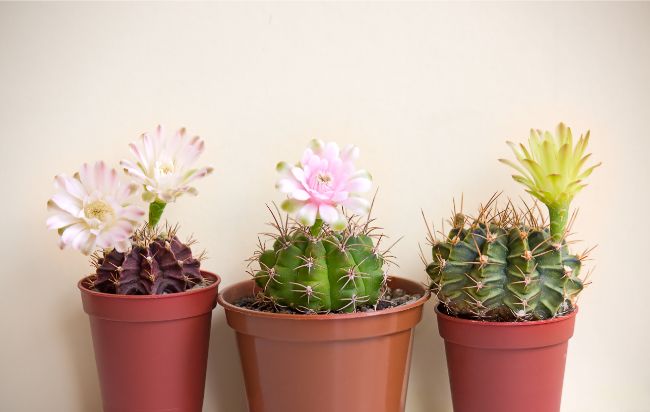
Cacti and succulents make for great starter plants for beginners. As succulents, they have very low-maintenance needs and are therefore ideal for those who forget to water and care for plants.
As they are highly-adaptable, they tend to survive even in difficult environments. Cacti simply need to be positioned in a bright or sunny spot and watered infrequently. Take care to ensure that the soil is well-draining – cactus potting medium can be bought ready-to-use.
11. Chinese Money Plant (Pilea Peperomioides)
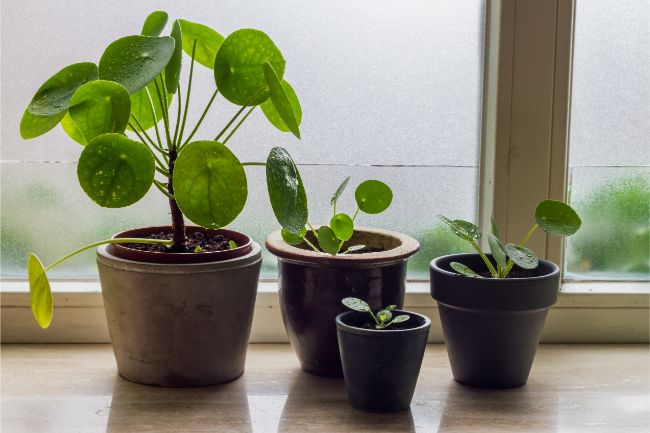
If you have a shelf or desk that needs a bit of greenery, the Chinese Money Plant or Pilea Peperomioides, often only growing to 10-12 inches in height, is the perfect choice. The Chinese Money Plant is a fairly rare and sought-after plant in the US, so if you are lucky enough to know someone with one, ask for a cutting. Its rarity doesn’t come from the plant being hard to grow – in fact, it’s quite an easy plant to care for.
This plant needs well-draining soil and minimal water. Only water the plant when the soil dries out. The plant will start to droop slightly when it needs a drink – just watch it and it will tell you when it needs a drink.
The Chinese Money Plant loves sunlight and will grow towards it (you may notice the leaves turning toward the sunlight), but it can’t have direct sunlight as it will wilt and burn. Simply place it near an east or west facing window. You can plant the Pilea Peperomioides in normal potting soil. Add some perlite for drainage to the growing medium and it should be happy.
12. Lucky Bamboo
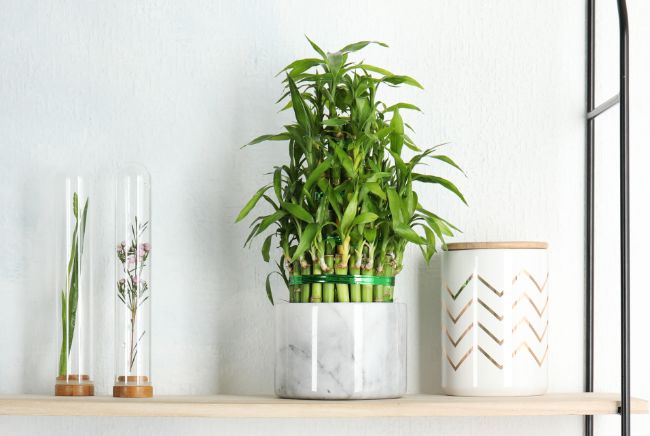
If you are looking for a really low care indoor plant, caring for a Lucky Bamboo could be it. Many people believe that the Lucky Bamboo brings prosperity and happiness. For a beginner, this is a great starter houseplant. It can grow in plain water or soil and isn’t too fussy about light conditions. Watch the plant – when it grows towards the light source, it is a sign that it needs more light.
Lucky Bamboo plants like bright indirect sunlight, as direct sun tends to burn their leaves. If you choose to grow the plant in a vase or jar of water, add some pebbles for support and opt only for bottled water, as they can be quite sensitive to chlorine often found in tap water.
They only need about an inch of water but you can add more if desired. If the roots are red, they are healthy and happy. Change the water at least once a week. If you choose to grow the plant in soil, choose well-draining potting soil and keep it moist but not sodden. Mealybugs and Spider Mites are the only pests to look out for, but they very rarely make an appearance on the plant.
13. Money Tree Plant (Pachira Aquatica)
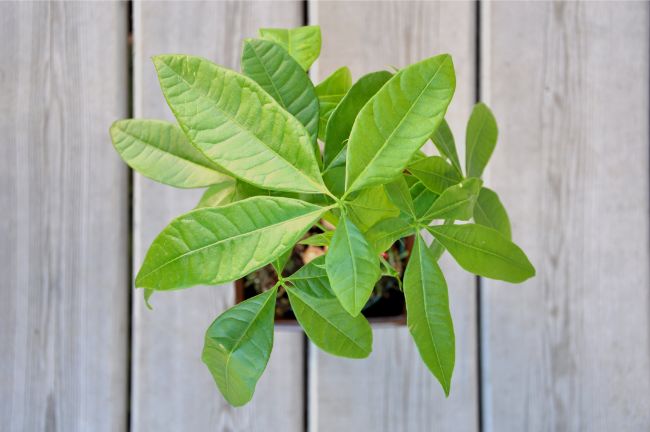
The Money Tree Plant is a good option for those looking for a low-maintenance easy growing plant. Some believe it brings luck and wealth; others simply love it for its unique, quirky appearance. This plant has an unusual braided trunk and bright green leaves. Unfortunately, much to the disappointment of many, the trunk is not naturally braided. This is usually done by hand when the plant is young and soft.
Indoors, the Money Tree grows to around 6 feet while in its natural habitat in central South America, it can grow to around 60 feet tall. Moderate indirect light is best for the Money Tree as direct sun can burn the leaves.
The plant is also known to fare quite well in low-light environments. The Money Tree makes for a great bathroom plant as it thoroughly enjoys steamy, humid environments. You only need to water the plant when the top 2 or 3 inches of the potting soil are dry. All you need is a sandy peat-moss based soil, a well-draining pot and a bright room to keep your Money Tree happy.
14. Devil’s Ivy (Pothos)
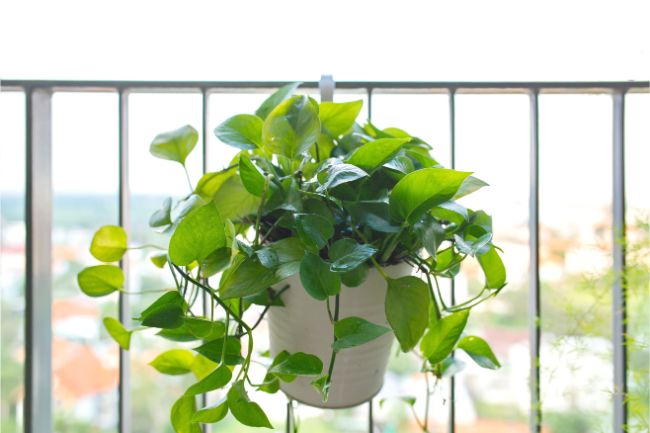
Devil’s Ivy (aka Pothos) is one of the best houseplants for beginners as it can thrive in unfavorable conditions. The Pothos only needs water on an infrequent basis, but when you do water it, it needs to be watered thoroughly. Devil’s Ivy doesn’t like to sit in water for too long, and therefore the soil needs to completely dry out between watering.
Because they like a lot of humidity, you should ensure there is reasonable humidity in your home, or think about locating your Pothos in a bathroom, or using a humidifier.
Beginners find the Pothos easy to care for as it is tolerant of various lighting conditions. It does best in indirect bright light. Avoid direct sunlight as this dries the plant out. One thing beginners need to be cautious of is the plant becoming root bound.
As soon as the Devil’s Ivy starts to outgrow its pot, it needs to be repotted into a considerably larger pot with nutritive soil. Pests such as mites can make their home on the Devil’s Ivy, but can be sent on their way by adding a few drops of liquid dishwashing detergent to a spray bottle of water and spraying the plant down.
15. Zebra Plant (Haworthiopsis Fasciata)
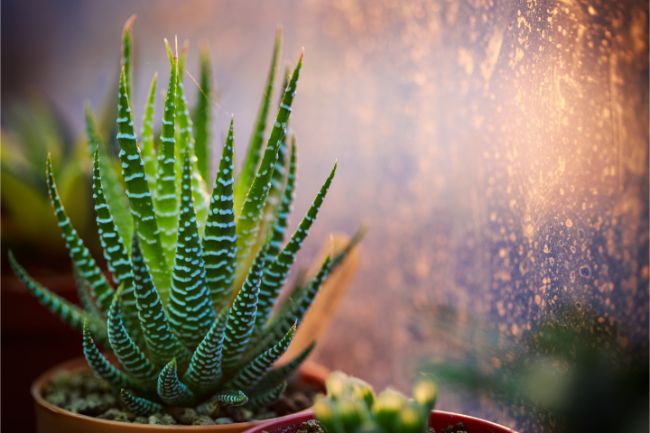
Beginners who want to start off small, only need to seek out the Zebra Plant, aka Haworthiopsis Fasciata (previously called haworthia fasciata). This is a very small colorful succulent from Brazil that forms fleshy, glossy green rosette leaves.
The plant has white bands and warts, thus its name. The Zebra Plant is extremely easy to grow. All it needs is bright indirect sunlight and sufficient moisture to thrive. The plant’s soil can dry out between watering, but not completely.
Reading the plant is very easy. If the leaves turn white or yellow, it’s receiving too much sun. If the leaves start to fade in color, they need more light. As they don’t like humidity, it is best to keep the Zebra Plant in a well-ventilated room, perhaps even a room with a fan.
Plant the Zebra Plant into fast draining soil (cactus growing medium is a good choice) – you can add perlite or gravel for best results. It only needs fertilizer once a year, in summer. The Zebra Plant grows best on an east or west facing windowsill.
16. Air Plants
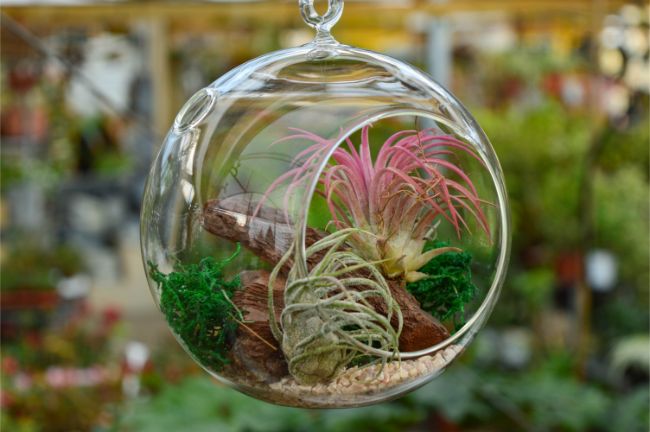
Plants that can grow and flourish without soil (Epiphytes) are great starter plants for beginners. There are over 600 varieties to choose from, most of which are native to Mexico & South America. These plants grow naturally on other trees, shrubs, rocks, and the ground. Drought-resistant air plants have silver foliage while green air plants tend to dry out a bit faster.
Air plants need good air circulation/ventilation to survive, so they do well in entrance halls and areas where traffic constantly flows between the indoors and outdoors. They are low-maintenance and only need to be watered once a week by being submerged for a few minutes.
They are sensitive to the sun and prefer moist environments with partial shade. Position your air plant in a bright room, away from direct sunlight. Some good air plants to start with include Tillandsia Lonantha Scaposa, Tillandsia Lonantha Guatemalan, Tillandsia Lonantha Fuego, and Tillandsia Argentea Thin, to name a few.
17. Boston Fern (Nephrolepis Exaltata)
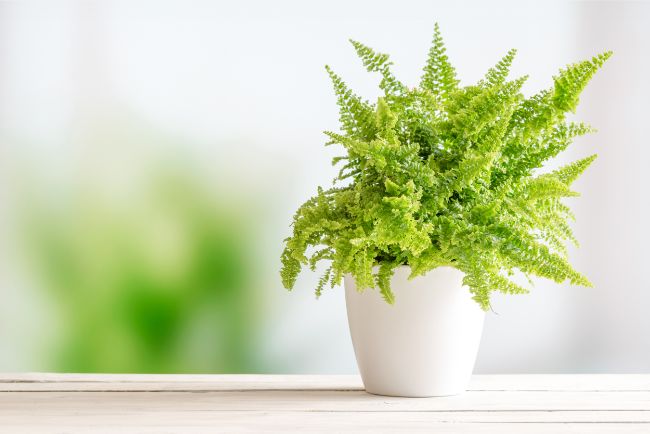
Boston Ferns are lush ferns with bright green leaves. While they are easy-growing plants, they do require high humidity and indirect sunlight. Without these needs met, the plant can show signs of distress. Place the Boston Fern in a humid spot or invest in a small humidifier. Misting the fern on a weekly basis can also help to keep humidity levels healthy for this plant.
The trick to growing a Boston Fern with success is keeping the soil moist at all times. The soil needs to be checked regularly for moisture, so this is not the plant for someone who is away from home for long periods.
The Boston Fern needs soil that has a high peat moss content and very rarely requires fertilizer. It is susceptible to Mealybug and Spider Mite infestation and can show serious negative effects if these pests aren’t taken care of promptly. While the Boston Fern isn’t the easiest plant in the world to nurture and grow, if you get your care schedule right, it can be quite rewarding to have.
18. Peace Lily Houseplant (Spathiphyllum)
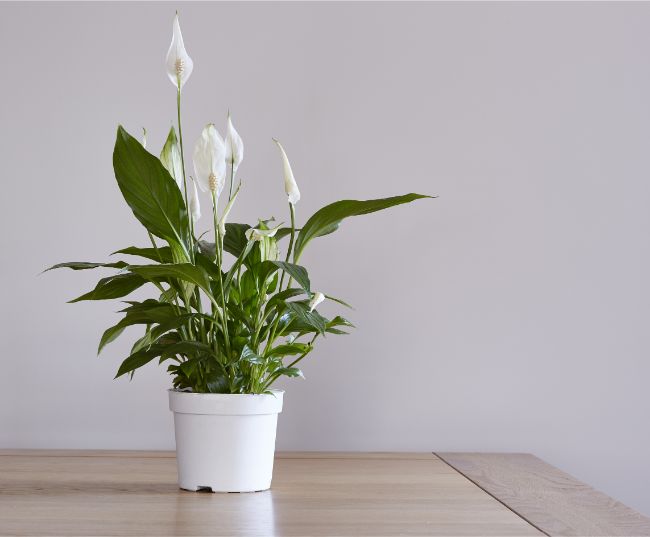
The Peace Lily is a fairly easy plant to grow. It features dark green leaves and white flowers in stark contrast. While it enjoys bright light, it doesn’t need direct sunlight. This makes it the perfect indoor plant. It grows best when placed in an east-facing window.
The Peace Lily requires well-draining potting soil and doesn’t need much in terms of fertilizing – a max of 3 feeds per growing season spaced 6 to 8 weeks apart is fine. The plant enjoys moist soil and may start to drop leaves and droop if it’s overwatered.
Some beginners are worried when the leaves of their Peace Lily start turning brown, but this could simply be a sign that tap water being used has high fluoride content. You can switch to bottled or distilled water to rectify the problem.
The houseplant typically enjoys a humid environment. Read my guide on the best ways to provide humidity for your houseplants. It’s important to note that the Peace Lily can be sensitive to changes in its environment. If it’s not thriving, it could be because of a draft or fluctuating temperature.
While the Peace Lily is a popular choice because it grows easily and requires minimal attention, it is toxic to children and animals, so should be placed out of reach of both.
19. Heartleaf Philodendron
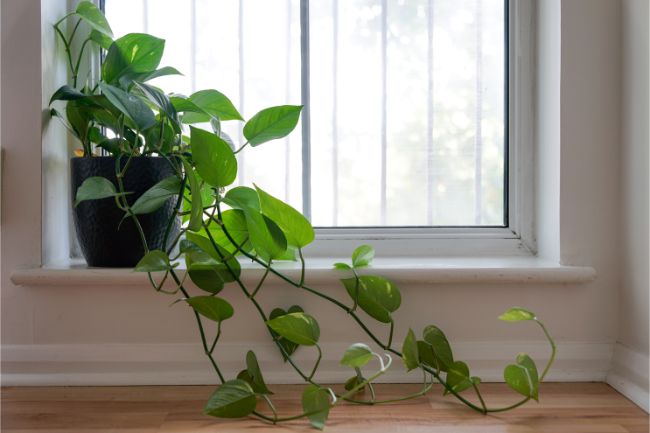
The Heartleaf Philodendron, aka Sweetheart Plant, is one of the best houseplants for beginners as it is such an easy indoor plant to care for. It features dark green heart-shaped leaf with a high natural shine. These make for great hanging or table-top plants.
The Heartleaf Philodendron only requires a moderate amount of indirect light and is happy for its potting soil to dry out between watering. Typically, Heartleaf Philodendrons only require water once a week.
The plant is easily pleased when grown in a well draining potting medium and fertilized every 6 to 8 weeks when actively growing. The only thing that beginners need to look out for with the Heartleaf Philodendron is small leaves or minimal new growth, which is often a sign of more fertilizer being needed.
While this hardy plant looks good and grows well, it is unfortunately mildly toxic to children and pets. Try place the plant on a shelf or table that is out of the reach of both.
20. False Shamrock / Purple Shamrock (Oxalis Triangularis)
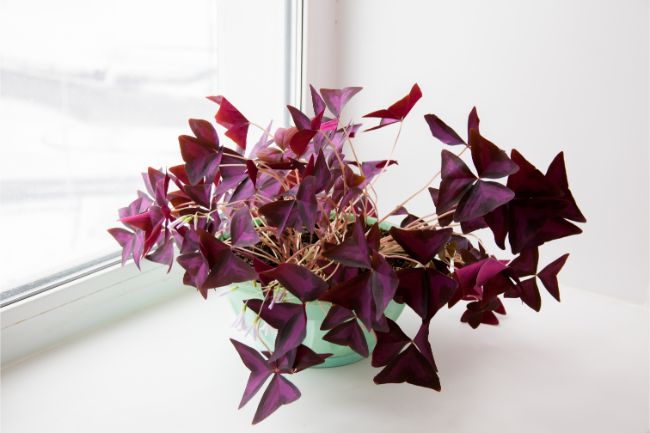
The False Shamrock is a delicate looking plant that only reaches around 6 inches in height, when fully grown. The deep purple leaves are clover-shaped and the blooms are miniature star-shaped flowers in a contrasting white/light pink color. At night, the leaves and flowers close, much like an umbrella.
My jaw dropped the first time I saw this amazing looking plant. As soon as I saw it, I ordered bulbs online the same day. I’ve had no problems growing this plant in a range of locations in my house.
Most people don’t know that the False Shamrock is actually an edible perennial. As such, it’s perfectly safe in a home with children and pets. Oxalis triangularis isn’t too fussy with light. It simply needs to be near a bright indirect light source. Watering should be done only when the top inch of soil has dried out.
This is a great plant for beginners who might forget to water, as the top foliage will die back during times of drought, while the bulb beneath the surface will remain dormant until it is watered again. Then the plant will begin to grow back.
These plants do well in a range of temperatures and humidity levels, so there is no need to worry about whether it will grow well in your home or not – it will.
21. English Ivy (Hedera Helix)
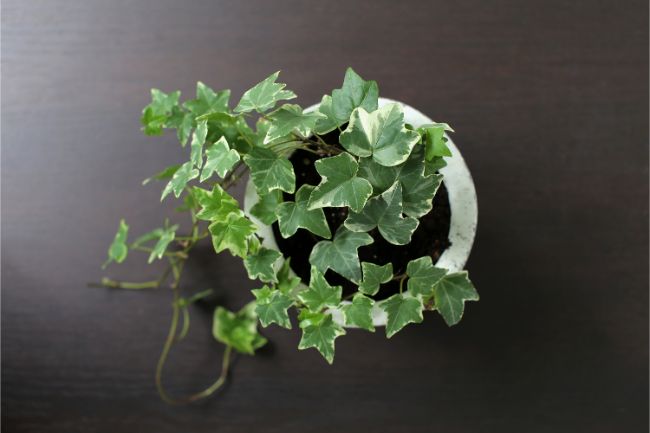
English Ivy plants feature thick glossy leaves that are dark green with white, yellow, or light green veins. These make for fantastic hanging plants, or plants set on a high shelf.
The English Ivy requires bright, indirect light and minimal water. In fact, you should only water the English Ivy when the soil has dried out at least 2 inches below the surface. The plant needs well-draining soil and nitrogen-rich fertilizer, which you should apply only once a month in spring and summer.
The English Ivy can gather dust and pests, so it’s important to check on it from time to time to make sure it is thriving. Read more about how to clean the leaves of your indoor plants here. Unfortunately, the plant is toxic to children and pets and tends to be attractive to both (kids and pets like to play with the hanging leaves).
22. Aloe Vera
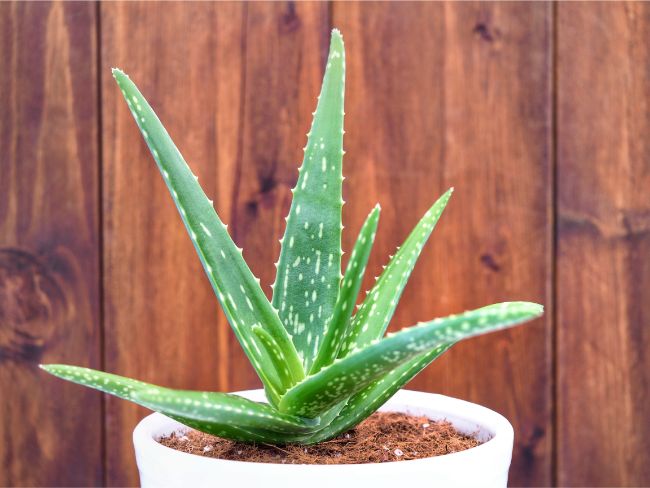
The Aloe Vera plant is a really popular and easy care indoor plant. The plant has bright green leaves in a rosette arrangement. These can grow as long as 20 inches in length.
The Aloe Vera is a great plant for beginners, as it can be left in direct sunlight for between 6 and 8 hours per day, with no negative effects. While it loves full sun, it does tolerate partial shade towards the late afternoon. Choose a window that faces south or west, for the best lighting arrangement. New owners of Aloe Vera plants should plant it in a sandy soil and water infrequently once at least half of the potting mix is dry.
Remember that the best way to water most houseplants is to wait until they dry out a suitable amount, and then water thoroughly, rather than giving the plant a little water on a more regular basis. During winter, watering can be reduced further as plant growth will be minimal.
Succulents are typically slow growing plants, but Aloe Vera is one of the fasting growing plants in this group. I’ve written about the rate of growth of Aloe Vera here. This really is one of the best houseplants for beginners as only minimal care is required.
23. Jade Plant (Crassula Ovata)
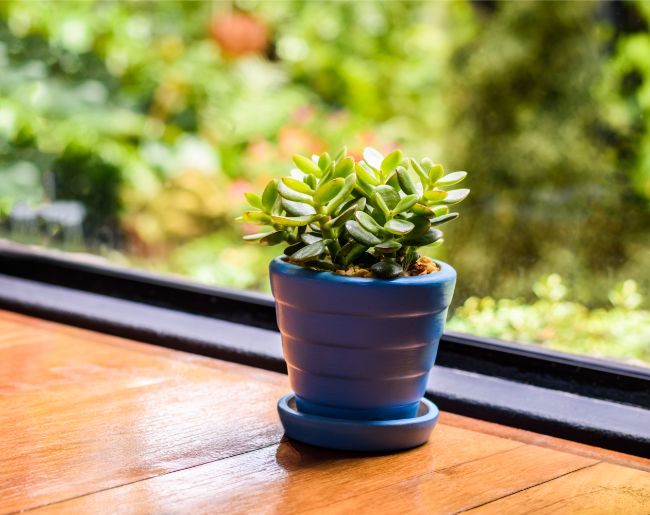
Jade Plants have attractive thick, waxy oval leaves and a thick woody stem. The Jade Plant is potentially one of the best succulents for beginners to make a start with, as they grow easily and aren’t remotely demanding.
The Jade Plant grown indoors doesn’t get too big. It enjoys partial or indirect sunlight and well-draining soil in order to thrive. All-purpose potting mix with some added perlite will encourage the plant to flourish.
Jade Plants like their environment to be warm and dry, but they aren’t as tolerant to drought conditions as other succulents are. These plants need a moist soil (not wet soil) during spring and summer, which are the growing seasons.
During winter, the plant goes into a dormant phase and soil can be allowed to dry out a bit. The Jade Plant is extremely susceptible to cold damage, so it’s best to keep them in rooms that are typically warm (away from air conditioners).
I’ve written one of the most comprehensive jade plant care guides to help you learn everything you need to know about growing a wonderfully healthy jade plant.
24. Rubber Plant (Ficus Elastica)
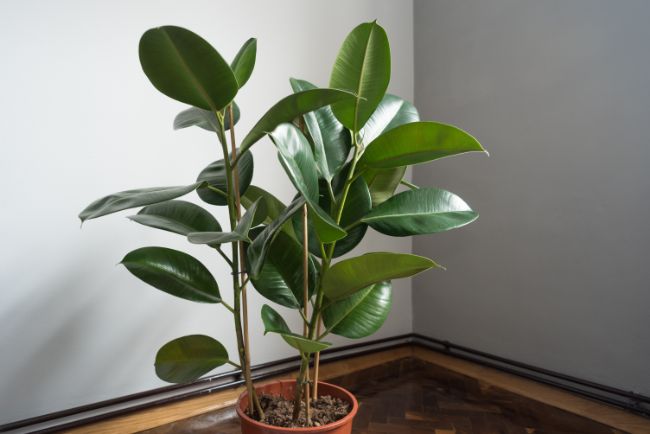
Rubber Plants have striking large oval-shaped leaves that are thick and glossy. New leaves have rosy colored sheaths while the more mature leaves are very dark green.
These plants can grow to 50ft tall or more in their natural habitat. Even indoors, they can often challenge the height of your rooms, so newbie plant owners must be willing to do some pruning to keep the height of the plant under control. It is important to get a Rubber Plant while it is still young as older plants may struggle to adapt to an indoor living environment.
The Ficus Elastica should be kept away from direct sunlight as it burns and dries out fairly easily. It requires bright indirect light and the soil must be kept evenly moist. This plant requires a bit more care than other beginner plants as they need higher humidity levels to remain in good health.
You should also be prepared to lean the leaves of the Rubber Plant, as the they tend to attract dust, which can be quite noticable due to the large, shiny surface of the leaves.
While fertilizer is not really required, it won’t reject being fertilized once a month during the spring and summer months. Unfortunately, the Rubber Plant may be toxic to pets.
If you want to know everything you need to keep a Rubber Plant in top condition, and avoid the problems that can arise, read my guide to looking after Rubber Plants Indoors.
25. Flaming Katy Houseplant (Kalanchoe Blossfeldiana)
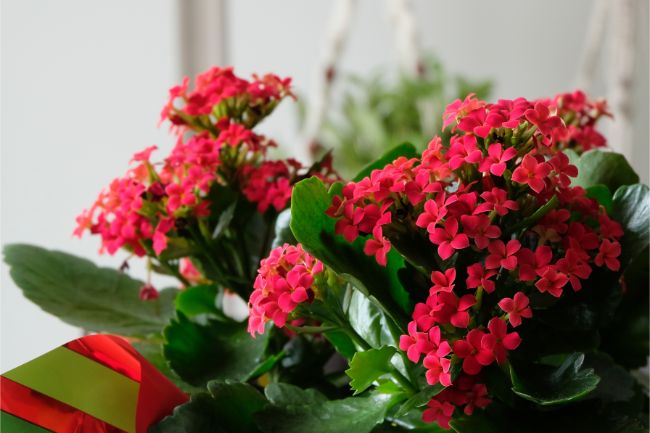
Beginners often choose the Flaming Katy plant for its physical appearance. This succulent produces copious flowers that bloom for months. There can be as many as 50 flowers in a flower head.
It comes as no surprise that these Flaming Katy is a popular gift plant. The highly attractive blooms can be yellow, lilac, orange, or red. The leaves are thick, fleshy and waxy which is typical of succulents.
Working with a Flaming Katy must be done with care as the leaf tips are prone to breaking. While the leaves are delicate, the plant is quite easy to care for. The soil needs to be kept moist while the plant is blooming. When the surface is dry, the plant can be watered again. Watering must be done with careful balance in mind. While the plant likes moist soil, being overly wet will lead to root rot, yellowing leaves, and leaf loss.
While this is a beautiful plant that is an attractive option for beginners, those who have pets should avoid it as it is poisonous to cats and dogs.
Many people treat Flaming Katy like an annual plant, discarding it once it has finished blooming, but they will live for years and rebloom year after year if cared for correctly. I’ve written a full guide to caring for Flaming Katy so you can keep your plant in great health and looking stunning.
26. Hindu Rope Plant (Hoya Carnosa Compacta)
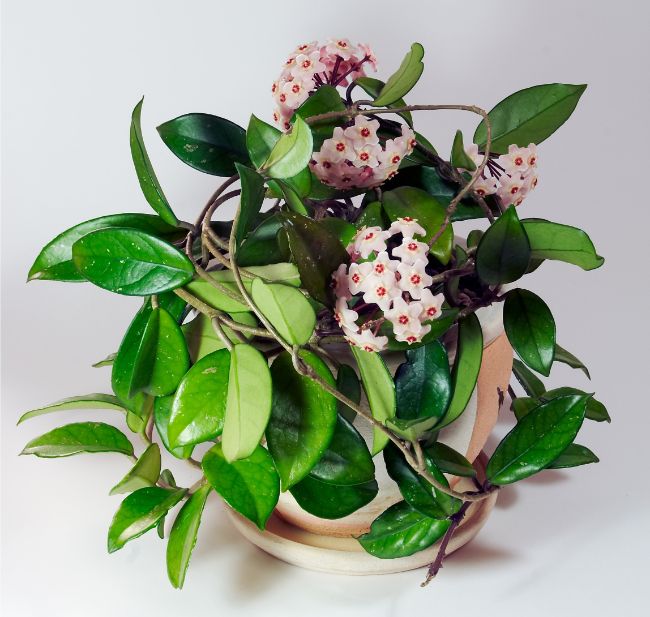
If you are looking for an easy-to-care-for houseplant with a quirky aesthetic appeal, look no further than the Hoya Carnosa Compacta. This plant has long rope vines that display bright green thick, twisted, waxy leaves. As the plant matures, it will begin to bloom clusters of pink, star-shaped flowers.
Although the foliage of Hoya Carnosa Compacta is amazing, it is the flowers that will leave you speechless. They are utterly stunning. Definitely one of the most beautiful flowers of any indoor plant.
Another reason this makes for a great beginner house plant is that it can remain in the same pot for many years – they don’t mind being a bit root bound. Simply fertilize the plant during the growing months (summer and spring) and ensure that it is planted in fast draining soil with added perlite, as they are highly-sensitive to overwatering. You only need to give the plant a light watering when the top 2 inches below the soil is dry. You can even wait for the leaves to start puckering before watering.
Light is important for the Hoya Carnosa Compacta, but it prefers indirect sunlight or artificial light. Don’t place the plant in the window, but rather near it, outside of the direct light. Sun can burn and dry out the leaves. As far as picking houseplants for beginners, this one is a good choice. If you want to learn to care for Hindu Rope Plant with ease and enjoy the stunning blooms, read my care guide here.
27. Ponytail Palm Houseplant (Beaucarnea Recurvata)
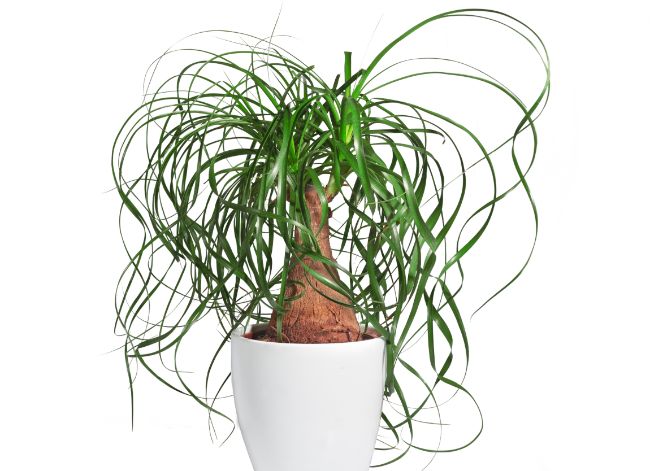
Ponytail Palms are elegant looking plants with bulbous water-storing trunks and long hair-like leaves that cascade from the top of the truck, much like a ponytail.
When growing a Ponytail Palm indoors, the leaves will be leathery and can grow up to around 3 feet long. Most don’t know that the Ponytail Palm is neither a plant nor a tree, but rather a succulent from the Agave family. It’s a great house plant for those worried about forgetting to water. The soil can and should completely dry out between watering.
In terms of light, the Ponytail Palm likes bright light, but will still thrive if it is in low-light half of the time too. New owners need to be aware that the plant can be sensitive to over fertilizing. Only fertilize the plant once or twice a year, during summer. Read all about why I think this is one of the best houseplants for beginners and learn how to grow and care for the Ponytail Palm here.
28. Arrowhead Plant (Syngonium Podophyllum)
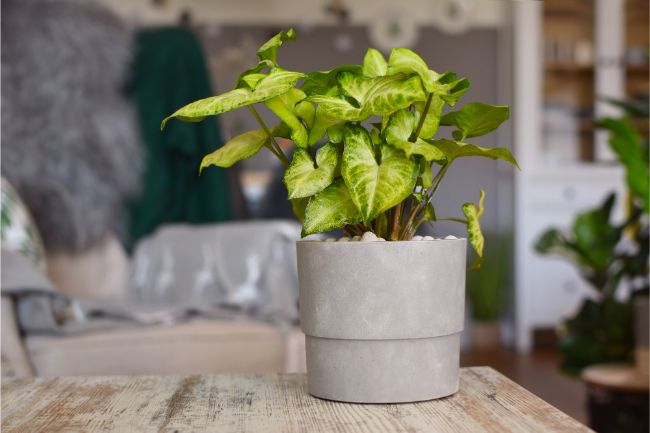
If you are a beginner looking for a low-maintenance, high-appeal houseplant, the Arrowhead Plant is a great option. It makes for a great hanging plant or plant set on a high shelf. The leaves, which are arrow-shaped, are cream, green, and white in color with occasional shades of burgundy and light pink.
The Arrowhead Plant is easy to care for. It needs to be located in a bright room, away from direct sunlight. Their potting soil can be all-purpose soil and you can let the soil dry out slightly between watering. Typically, these plants only need water less than once a week when grown indoors.
The leaves of this houseplant shed regularly, as they dry out and get replaced with new, young leaves. It is important to clear dropped leaves away quickly as the plant is toxic to children and animals. If ingested, the Arrowhead Plant leaves can cause skin irritation, an upset stomach or vomiting.
If you don’t have children or pets, you can hang the Arrowhead Plant and let it grow at will. It can and does put on quite a display when it merely gets enough light and water. Read more about caring for the Arrowhead Plant here.
29. Flamingo Flower (Anthurium)
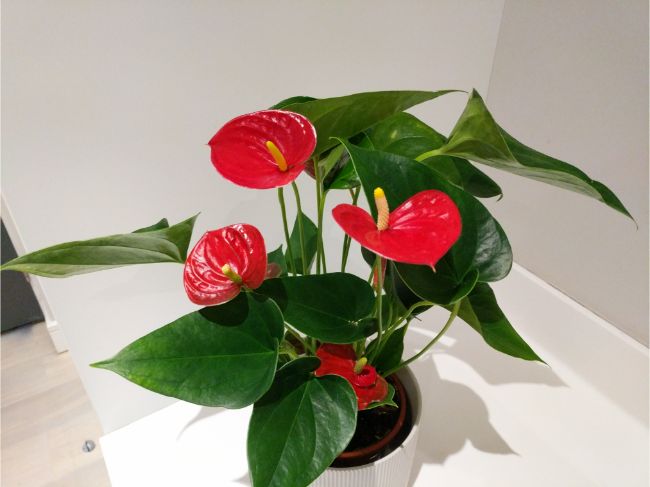
Flamingo Flowers have dark green, durable leaves and interesting deep-red flowers that grow in a heart shape. The flowers of the plant are actually spathes, which form a protective barrier around the plant’s spadix. A peculiar quirk of the plant is the fact that sometimes the roots make an appearance above the soil, even if it is not root bound and suffering no problems. This is completely normal.
One of the things I love about Anthurium houseplants is that they provide color all year round with very little effort. Beginners need only provide their Flamingo Flower with coarse potting soil (with added perlite and peat moss), and position the plant in a sunny spot with indirect sunlight to make it happy. Direct sunlight can burn the plant’s leaves and dry it out.
Anthuriums are happiest in humid environments. If the leaves lose their glossy look, it’s time to provide the plant with more moisture. Use a humidity tray, get a humidifier or relocate the Flamingo Flower to the steamy bathroom to rectify the problem. For other ways to increase humidity for indoor plants, see my article.
The Flamingo Flower is definitely not a good houseplant for homes with pets as they can cause serious calcium oxalate poisoning. The result of which can be severe kidney and liver damage. The ASPCA is a great resource for checking the toxicity of your indoor plants.
Another favorite of mine, I’d love to share some of my best tips to keep your Anthurium thriving. This is a plant that I think is one of the best houseplants for beginners and, as long as you take care with pets and children, will make a wonderful addition to your home.
Last Word
I hope this article has been useful in helping you pick some great houseplants for your home. I’ve tried to pick out some of the best house plants for beginners, not just because many of them are easy to care for, but because they look fabulous.
I get such pleasure from the beauty and interest that indoor plants bring to my home, and the options are endless. If you’re still not sure what houseplant is right for you, I have made a quiz that will help you to pick your perfect houseplant. It takes less than a minute to do and will pick a houseplant for you based on your needs and home environment.





